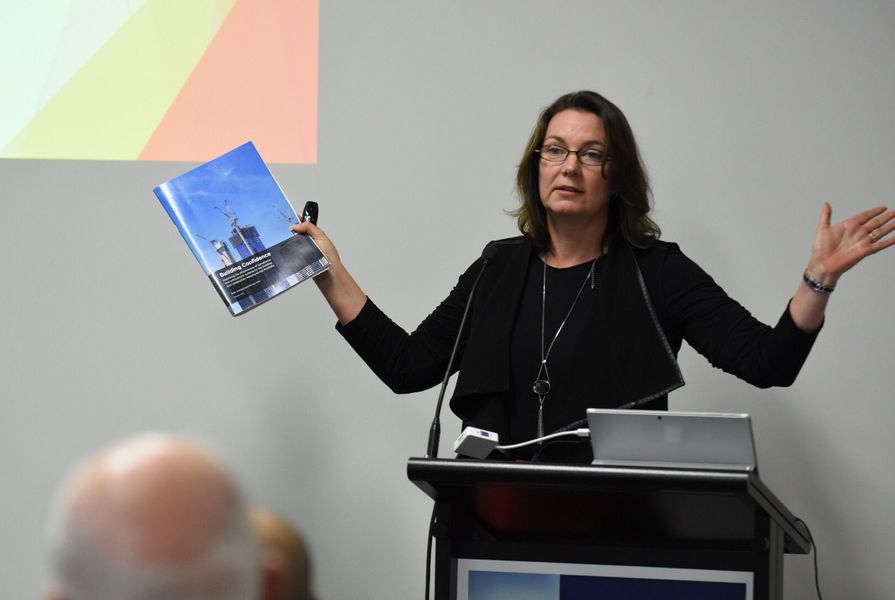Many were surprised by Judge Ted Woodward’s decision in the Victorian Civil and Administrative Tribunal hearing regarding the fire at Melbourne’s Lacrosse Tower.1 The builder was not apportioned a share of damages despite having undertaken to design and construct the building. Instead, the builder was able to deflect responsibility for non-compliant work to its consultants, namely the building surveyor, architect and fire safety engineer.
The decision, now under appeal, has caused many architects to question the impact of novation on their ability to perform their work and how they can best manage liability.
What was the Lacrosse case about?
The Lacrosse building, a twenty-one-storey residential and retail tower in Docklands, Melbourne, was constructed between 2010 and 2012. On 24 November 2014, a fire occurred as a result of an occupier leaving a cigarette in a plastic food container on a balcony table. The fire spread rapidly up the building via the highly combustible aluminium composite panels on the facade, rising thirteen storeys in about twelve minutes. Approximately four hundred people were evacuated but there were no serious injuries.
The focus of the tribunal was on the selection, approval and installation of the aluminium composite panels used as cladding. The owners sought damages from the builder, claiming it had breached statutory warranties by installing non-compliant cladding. The builder joined various parties, including the building surveyor, fire safety engineer and architect, all of whom had been novated to the builder as consultants under a design and construct contract.
While the builder and its three consultants were all found to have breached their respective contracts, the builder was found to have reasonably relied on the other three consultants, to whom 97 percent of the damages payable by the builder were apportioned.
The architect’s conduct
The architect specified that the aluminium composite panel (ACP) cladding for the balconies was to be “indicative to Alucobond.” During construction, a substitute product – later found to be highly combustible and therefore non-compliant – was used. In its defence, the architect argued that the novated contract passed all responsibility for the design from the architect to the builder. The tribunal disagreed, finding that the services the architect agreed to provide in its consultant agreement included the preparation of contract material that would satisfy the legislative requirements applicable to the design, including those of the Building Code of Australia (BCA). Having found that the ACP product used was not compliant with the BCA, it followed that the architect’s conduct in specifying “indicative to Alucobond” was in breach of the contract.2
This decision confirms that courts will expect architects to prepare documents that demonstrate BCA compliance. The involvement of other specialist consultants does not relieve the architect from its obligation to understand and apply the BCA to its design.
Novation and the role of the builder under a “design and construct” arrangement
In April 2019, the Australian Institute of Architects conducted a national survey on the outcomes of procurement methods that involve novation of the architect.3 Among Victorian respondents, the survey found that where a novated contract was in place: rates of product substitution were higher and more likely to have a negative impact on finish and durability; there was lower commitment to ecologically sustainable design; architects were less likely to be included in project control meetings and they reported being denied site access; builders were more likely to take shortcuts in certification; architects had increasing responsibilities for all aspects of construction yet diminishing power and influence over design and constructability outcomes; the contractual terms required by the builder impacted negatively on the architect’s ability to deliver quality outcomes; the architect was less likely to be able to protect the interests of the developer; and architects were often unable to increase their fees to suit increased workloads, leading to an inability to provide adequate resources and to adverse health and wellbeing outcomes for staff.
Some of the findings of the Institute’s survey are consistent with the evidence given by the architect in the Lacrosse matter. In the hearing, the architect reported a lack of consultation and a failure by the builder to ask for or take the architect’s advice.4 The architect argued that its role was diminished, that it was not treated as the “head design consultant” and that it therefore should not be attributed responsibility for that role. In the tribunal’s opinion, however, the actual relationship did not override the contractual obligations.
In light of the Lacrosse case and the results of the Institute’s novation survey, there are ways that architects can better protect themselves. They must understand clearly what obligations they are agreeing to under any contract and price their services accordingly. Where they are unable to obtain enough information to do that, their price should be appropriately qualified.
During the project, where the architect is being prevented from performing its services – such as being denied access to the site or not being included in essential meetings – it needs to raise these matters with the builder in writing, referring to its rights and any remedies it may have under the contract. The ability to seek additional fees will depend on the terms of the contract. Unless an architect has negotiated the ability to increase fees based on clearly defined events, the only way to mitigate against increases in scope will be via contingencies that are priced into the original fees.
Put simply, the contract you sign can only protect you if it has been negotiated fairly and if you enforce your contractual rights when you are being prevented from performing your role. It is vital for those in the profession to support each other in order to reach a common position on what is acceptable and to lift the benchmark for fair contracting.
— Bronwyn Weir is the co-author of the Building Confidence Report. She has more than twenty years’ experience advising governments on regulatory issues.
1. Owners Corporation No. 1 of PS613436T v L. U. Simon Builders Pty Ltd (Building and Property) [2019] VCAT 286, 28 February 2019, vcat.vic.gov.au/resources/owners-corporation-no1-of-ps613436t-owners-corporation-no-2-of-ps613436t-owners (accessed 17 September 2019).
2. Owners Corporation No. 1 of PS613436T v L. U. Simon Builders Pty Ltd (Building and Property), 159–160.
3. Australian Institute of Architects, “The benefits and challenges of novation for architects – Victoria,” August 2019, architecture.com.au/wp-content/uploads/Australian-Institute-of-Architects_Novation-Survey_Victoria-2019.pdf (accessed 17 September 2019).
4. Owners Corporation No. 1 of PS613436T v L. U. Simon Builders Pty Ltd (Building and Property), 149.
















